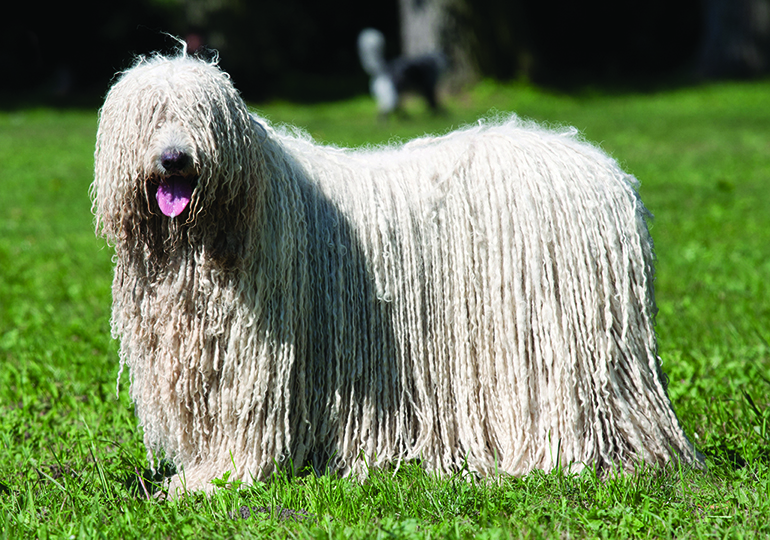Breeds
Komondor

GROUP 5 - WORKING DOGS
History
Komondorok were brought to Hungary by Cumans, the Turkic speaking, nomadic people who settled in Hungary during the 12th and 13th century. The name Komondor derives from Koman-dor, meaning "Cuman dog". The breed descends from Tibetan dogs and came from Asia with the Cumans, whose homeland might have been near the Yellow River. In the late 10th century, Mongols began to expand their territories at the expense of the Cumans, forcing them to move westwards. Fleeing from the Mongols, they reached the borders of Hungary in the 12th century. Cumans were granted asylum and settled in Hungary in 1239 under Köten Khan. (1)(2)
Appearance
The Komondor is large in size and powerfully built. His appealing outward appearance and dignified deportment arouse respect and even fear in the observer. By nature he is not ingratiating. His robust body is covered in matted, corded, dense throughout, long hair. The coat colour is ivory. (3)
The Komondor's coat is long, thick, and strikingly corded, about 20 – 27 cm long (the heaviest amount of fur in the canine world), which resembles dreadlocks or a mop. The puppy coat is soft and fluffy. However, the coat is wavy and tends to curl as the puppy matures. A fully mature coat is formed naturally from the soft undercoat and the coarser outer coat combining to form tassels, or cords and will take around two years to form. Some help is needed in separating the cords so the dog does not turn into one large matted mess. The length of the cords increases with time as the coat grows. Moulting is minimal with this breed, contrary to what one might think (once cords are fully formed). The only substantial shedding occurs as a puppy before the dreadlocks fully form. (1)(4)
Temperament
He has an imperturbable courage in the guarding and defence of the herds entrusted to him and the property and home of his master. He attacks silently and enduringly. He regards his territory as his own property and will not tolerate any other living creature in it. His nature is suspicious. During the day, he likes to keep a lying position enabling him to control his area. At night, he is always on the move.(3)
Due to the Komondor's size, power, speed and temperament, a lack of obedience training can result in danger to others. Komondors generally take well to training if started early (ideally between 4–8 months). A Komondor can become obstinate when bored, so it is imperative that training sessions be upbeat and happy. Praise is a must, as are consistent and humane corrections. Once a Komondor gets away with unfriendly or hostile behaviour, it will always think such behavior is appropriate. Therefore, consistent corrections even with a young puppy are necessary to ensure a well-adjusted adult. Socialisation is also extremely important. (1)(4)
The Komondor should be exposed to new situations, people and other dogs as a puppy. Because it is a natural guard dog, a Komondor that is not properly socialised may react in an excessively aggressive manner when confronted with a new situation or person.(1)
Sizes
Height at withers: Dogs: Minimum 70 cm, Bitches: Minimum 65 cm
Weight: Dogs: 50-60 kg, Bitches 40-50 kg
In Conclusion
Now you know a little about the Komondor you may have think that this is the dog for you. Before you make a decision, please make contact with the breed club or your State controlling body for purebred dogs. They will be able to give you information about available puppies and also suggest dog shows where you can see the breed and speak to breeders. In this way you will gain a better perspective of the Komondor and its needs and whether this breed would suit your lifestyle.
References
- Dogs Australia
- Wikipedia.org
- The early history of the Komondor". Komondor.org
- Heaney, Richard; Therese Heaney (1995). "Komondors". K9web.com
Image: Shutterstock.com
Breeders
Sorry, there are currently no breeders advertising for this breed. If you are a registered Dogs SA breeder and wish to advertise here please create an advertisement here.

